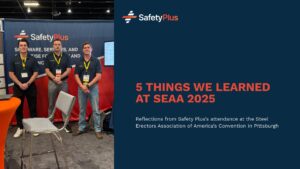Contractor Management that Ensures Compliance Down to the Employee Level
Reimagining Contractor Qualification:
Contractor Management That Ensures Compliance Down to the Employee Level
Contractor Qualification (CQ) has been around for some time. Larger facilities face the paradoxical responsibility of safety compliance for employees that are not their own but are performing work on their job site. Since it would be near-impossible for owner/operators to implement an all-encompassing safety management program for another company’s employees, CQ programs allow owner/operators to pre-qualify sub-contractor companies to ensure adequate historical safety records and standards. While most CQ programs do a decent job ensuring sub-contracting companies meet certain metrics of safety during the Pre-qualification process, they stop short of ensuring only qualified employees are performing tasks on their jobsites. Through the simple application of existing technologies, Contractor Qualification programs can be improved to track ongoing compliance down to the specific tasks performed by individual employees.
Common CQ Program Requirements
Establishing Risk Thresholds: The owner/operator sets various risk thresholds and tier standards that contractors, sub-contractors, and vendors must meet in order to be able to perform work at their facility/jobsite.
Total Recordable Incident Rate (Typically must be < 4.0)
• Lost Workday Rate (Typically must be < 1.0)
• Experience Modifier Rate (Typically must be < 1.0)
Supporting Documentation: The owner/operator requires various documents and records be uploaded during the pre-qualification process, including:
• Contractors Licenses
• Tax ID
• Proof of Incorporation
• OSHA 300A Logs
• Various insurance documents
Questionnaire: The owner/operator requires all subcontracting companies to complete a specific questionnaire that asks about company history, financial strengths, job size capabilities, jobsite safety, and more.
Safety Policies: Based on answers to the questionnaire and the type of work the sub-contracting company will be performing, owner/operator requires the sub-contractor to submit their company’s policies/manuals for the hazards they will encounter on the jobsite.
Training Records: Based on answers to the questionnaire and the type of work the sub-contracting company will be performing, owner/operator requires the sub-contractor to submit training records for the subjects relevant to the tasks their employees will be performing on the worksite.
The problem with the current CQ Program model is that it focuses on past performance when it is the safety performance of the company in the near future that owner/operators should truly care about. While past performances can be an indicator of future performance, there are better ways to ensure ongoing safety management. Additionally, the current model relies on the honesty of the applying subcontractors. No contractor is going to make itself look bad while applying for a job. Even if the company looks great on paper, this may be through sheer luck or under-reporting of incidents over the past few years. Finally, and perhaps most critically, the current CQ model’s focus is on the sub-contracting companies and not on the sub-contracting employees. Companies don’t get injured. Companies don’t drive forklifts, work in confined spaces, or on scaffolds. Employees do. Every effective safety program puts employees first; CQ Programs should do the same.
Improving the Current CQ Program Model Down to the Lowest Common Denominator
Imagine you are the Safety Manager for a worksite with over 150 employees representing 15 different sub-contracting companies present on the site today. Sub employees are performing a myriad of hazardous tasks including forklift operations, confined space work, and scaffold work. How do you ensure that any given employee is qualified to perform the task he/she is assigned? By tracking sub-contractor employees in a single database, owner/operators can add these elements to their CQ Program and dramatically improve safety performance across their worksite, ultimately decreasing liability.
Auditing Employees in Real Time: Requiring subcontractor training to be uploaded to a cloud-based database allows owner/operators to check any sub-contractor employee’s training records in real-time on the jobsite.
Ongoing Safety Management: Require subcontractors to submit proof of ongoing safety management to keep safety on everyone’s mind: Daily JSA’s & Weekly Safety Meetings
Badging Employees: Require subcontracting employees to badge in at the gate. Add the following requirements to all subcontracting employees to standardize safety down to the employee level:
• Drug tests
• Background checks
• Training verification
• Site-specific Orientation
*Badging also allows owner/operators to know who is on their site at any given time.
At the end of the day, owner/operators and subcontracting companies are both responsible for the safety of employees on the worksite. While the owner/operator shares this responsibility, sub-contractors would do well to recognize the importance of safety, both for their employees’ wellbeing and for the potential of future work with the client. Shifting Contractor Qualification programs to focus on individual employee safety and emphasize continued safety monitoring increases overall compliance, reduces incidents, injuries, and contractor employee turnover, and ultimately achieves a significant return on investment for everyone involved.
Recommended Reading
National Safety Month: Reducing Preventable Injuries and Deaths
Every June, National Safety Month reminds us that many injuries and deaths are preventable, whether at work, at home, or on the road. While safety should be a priority throughout the year, this annual initiative gives everyone a chance to slow down, evaluate risks, and take steps to mitigate them. Job site injuries, car accidents,…
The Hidden Costs of Workplace Incidents (and How to Avoid Them)
Workplace incidents can be costly on multiple fronts, from direct costs like medical and legal fees to indirect costs like lost productivity and reputational damage. The ripple effect of a workplace injury or death can last far beyond the incident itself, eating away at profitability and damaging a company’s reputation. However, the right safety measures…
Partner Spotlight: MASC Safety Consulting – Machine Safety & Compliance Expertise for High-Hazard Operations
At Safety Plus, we recognize the critical importance of machine safety and regulatory compliance in industrial operations. To support our clients in achieving these objectives, we are proud to spotlight MASC Safety Consulting, a firm that provides comprehensive safety services tailored to industrial operations. Featured Resource: Comprehensive Machine Safety Services Available Through Our Partner Network…
5 Things We Learned at SEAA 2025
Reflections about trends in the steel erection industry from Safety Plus’s attendance at the Steel Erectors Association of America’s Convention and Trade Show in Pittsburgh The 2025 SEAA Convention & Trade Show in the Steel City of Pittsburgh was nothing short of inspiring! Safety Plus was humbled to sponsor and exhibit at this event for the…
SAFETY MANAGEMENT SIMPLIFIED
Prevent Tragedy and Scale Effectively by Making Safe Work Efficient




